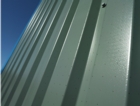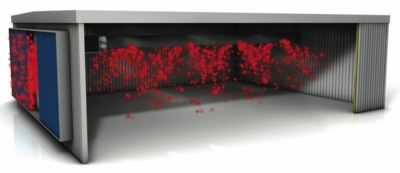Solar energy becomes another ‘brick’ in the wall

Sources of renewable energy that can be used in buildings to reduce carbon emissions and comply with planning-permissions requirements for onsite renewable energy are limited. What’s more, they tend to have rather high capital costs and can pose other planning-permission issues — especially wind turbines.
Other technologies that are well established in the UK include solar thermal to meet up to half a building’s annual requirement for domestic hot water, heat pumps (air source and ground source) and solar photo-voltaics.
What all these systems have in common, of course, is exploiting solar energy — either directly in the case of solar thermal and solar PV or in stored form in the air or the ground in the case of heat pumps. All these technologies have been known in the UK for decades.
About three years ago, another approach to exploiting renewable energy arrived in the UK from Canada and has been attracting a lot of high-level interest for heating large open spaces such as factories and warehouses — ‘sheds’ in other words. It was first featured in Modern Building Services in June 2007. A range of installations since then have demonstrated its capabilities, and one project has been extensively monitored by BSRIA, namely that at the CA Group roll mill in Evenwood, County Durham.
Called SolarWall, the concept uses solar energy to deliver naturally warmed fresh air into buildings to provide heating. It can be applied to new buildings and refurbishment projects to achieve up to a 50% reduction in heating costs and provide up to 20% of a building’s total energy requirements. Payback on the extra capital cost is relatively short — as low as three years for a new building and within seven years for refurbishment projects. What’s more, it is claimed to be carbon neutral in the first year of operation. There is minimal impact on building aesthetics.
In the UK, SolarWall has been developed by CA Group and Corus specifically for the UK market. AmbiRad has also been involved in harnessing the warm air generated by SolarWall and utilising it effectively.
The cost-effectiveness of SolarWall is revealed by an independent study of the potential of onsite renewable energy generation on a development in Cambridgeshire undertaken on behalf of South Cambridgeshire District Council. The aim was to reach a renewable-energy target of 10% of the total energy demand of a mixed-use development of about 13 600 m2. More detailed figures are given in the table, but the summary is that SolarWall came in at a third of the cost of a wind turbine and less than a quarter of the cost of a ground-source heat pump.
Succinctly described as a perforated transpired solar collector, SolarWall takes the form of a large panel faced with Corus’s Colorcoat Prisma prefinished steel. The outside surface is heated by sunlight so that air drawn through small perforations in its surface is heated for controlled introduction into the building by air-handling units or ductwork. The only moving part in an installation is the fan. The perforations are very small, 1.5 mm in diameter, to prevent water ingress, and there are thousands of them per square metre. The external panel can be styled to resemble existing cladding or the rest of the cladding on a new building; it stands 100 to 300 mm proud of the rest of the building.
Colorcoat Prisma has metallic particles embedded in its coating to absorb heat and is available in a range of colours. Even lighter colours do not suffer much of a fall-off in heat-gain potential. The efficiency of SolarWall can be up to 50%, so 1 kW of solar gain can give 500 W of usable energy. The temperature of the incoming ambient air can be increased by as much as 22 K. Even by night, SolarWall can help reduce heating costs by recapturing radiant heat from the building that would normally be lost and recirculating it within the building. Heat that would otherwise be lost due to air leakage can also be recaptured.
By delivering this preheated air at high level through ductwork, warm air that would otherwise accumulate at high level is taken back to floor level, avoiding the wasteful effects of stratification.
In Summer, SolarWall can act as a ‘blanket’ to reduce solar gain within the building. In addition, a bypass damper immediately in front of the fan inlet duct can be set to open as a set temperature to circumvent the air-heating system and allow cooler external air into the building.
CA Group has a host of case studies, including both new and refurbishment projects, demonstrating the capabilities of SolarWall.
A fine example of SolarWall helping to achieve an energy-efficient refurbished building is the technical training academy of Jaguar Land Rover at Leamington Spa. The company had taken over a 23-year-old building that had been derelict for 23 years. It had low levels of insulation and, being of lightweight construction, little thermal mass.
To improve the thermal performance of the building, 75 mm of insulating foam was sprayed onto the internal surfaces of the workshop.
268 m2 of SolarWall was installed on the South elevation of the building inclined 21° from the vertical. The finish chosen was Ariadne, a silver-grey colour, to harmonise with the existing cladding. Not only does the SolarWall provide one to two air changes an hour, but it is also expected to deliver annual energy savings of 80 MWh, corresponding to 19 t of CO2.

Heated air is distributed through two textile socks at high level and entrains about four times its own volume of air from the space.
The old gas-fired unit heaters with 2-stage burners were retained, but are seldom used — especially at high fire. Their main purpose is to get the building up to temperature at the start of day, after which the SolarWall takes over.
The system has been running for a year now, and a graph produced by the site-wide Trend building-management system in March 2009 shows that the SolarWall easily increases the temperature of incoming ambient air by 15 K. Air delivered at 23°C more than meets the heating requirements of the workshop.
The Jaguar Land Rover project came about in response to the board’s call to identify as many cost-efficient energy-saving technologies as possible to show developers around the world what could be done — and then multiply the benefits. 20 technologies were selected out of 30 considered, costing £250 000 — and the cash was forthcoming.
Actual operating figures from March last year showed an ambient temperature of 3.6°C being raised to 17.5°C to deliver 10% fresh air. This was mixed with return air to achieve a supply temperature to the workshop of 18.5°C.
A much larger project is Premier Park, a new warehouse and office development in Winsford, Cheshire. This project has 580 m2 of SolarWall, which is delivering 130 MWh of energy savings a year — corresponding to 32 t of CO2.
Intriguingly, although the local council required this development of five units to generate 10% of its energy requirements from on-site renewables, it was reluctant to grant permission based on SolarWall — preferring instead to insist on solar photo-voltaics. The problem was resolved by referring the project to the Carbon Trust, which telephoned the local authority to express its ‘disgust’. In the event, the SolarWall installation on just one of the five buildings on Premier Park site was sufficient to meet the 10% renewable requirement for the whole site.
The most closely monitored installation is CA Group’s own roll mill in County Durham, which was monitored by BSRIA for 12 months. Instrumentation included 32 thermocouples embedded in the wall, two in the delivery duct, one in the building and one outside below the SolarWall. There was also a pyranometer for measuring solar radiation in the plane of the SolarWall. All the instrumentation was connected to a PC. There were also two external and seven room sensors for temperature and humidity, as well as a sensor for duct temperature and humidity. Finally, a set of sensors on a rack monitored air temperature stratification.
The results showed that the energy drawn from the SolarWall and delivered to the building over 12 months amounted to 21% of the total heating energy used — about 79 MWh of a total heating use of 375 MWh. That figure is well above the 10% requirement for renewable energy.
The SolarWall and other energy-saving features of the system halved the consumption of gas for heating compared with the previous year, after allowing for degree days. CO2 emissions were reduced by nearly 59 t. The total heating requirement met by gas and SolarWall was reduced by 37% by the energy-saving features of the system alone.
Consulting engineers Battle McCarthy have also carried out a study on the SolarWall for the CA Group, which comments on the BSRIA report — notably the energy-saving features. Two factors contribute. One is destratification, which continues to be effective in reducing heat demand even when the SolarWall is not supplying heat. The other is positive pressurisation of the building preventing cold air blowing in directly through open doors.
It is generally accepted that there is no one silver bullet to address the carbon-reduction agenda and renewable-energy requirements, but SolarWall is a significant addition to the armoury. The low temperature requirements of its delivery system, well below 30°C, hint at the possibility of heat pumps to replace gas when sufficient direct solar energy is not available. But heat pumps, especially ground source, have a higher capital cost than SolarWall, so perhaps we should save that option for the future — especially if the electricity supply becomes decarbonised.









